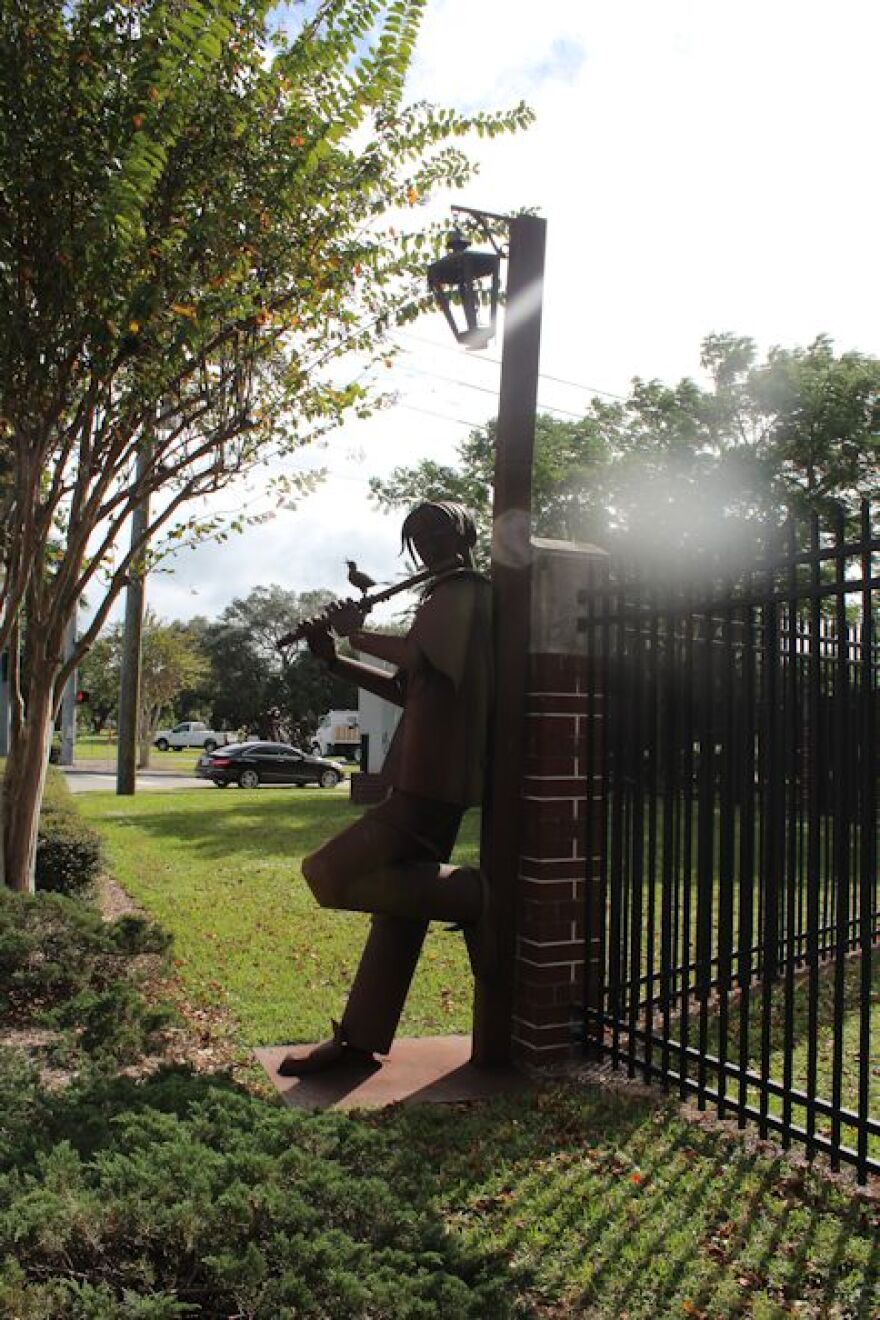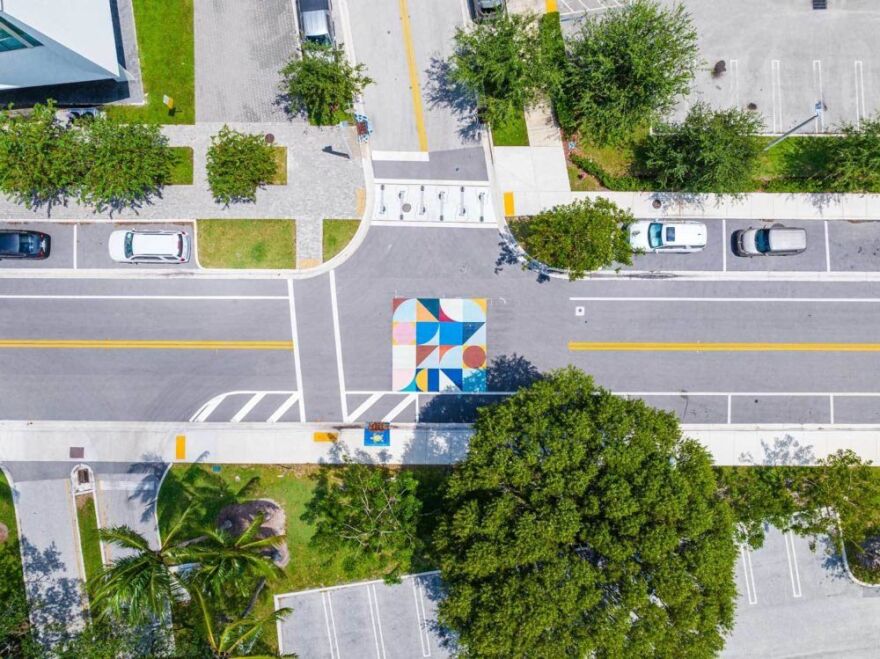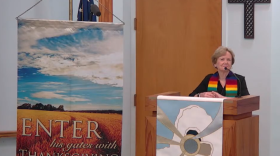Editor's note: This story updates an earlier version.
Last week, Fort Myers Mural Society Executive Director Shari Shifrin learned that the city of Sarasota is removing more than 200 hand-painted sidewalk panels that line Pineapple and Orange avenues in Sarasota’s historic Burns Court arts and culture district.
“It’s a shame to lose that project,” Shifrin responded. “It is quite phenomenal.”

Shifrin has more than a passing interest in those murals. Several artists who are members of the Fort Myers Mural Society participated in the project, which was sponsored by Avenida de Colores, the nonprofit that stages the annual Sarasota Chalk Festival. They joined members of the Sarasota Mural Society and students from Ringling College of Art and Design and Booker High to paint murals on Sarasota sidewalks that pay tribute to that city’s artistic landmarks and attractions.
“Every one of those sidewalk squares are a historic vantage point to Sarasota and its community throughout the last 150-year history, right down to several pieces depicting the original Ringling Circus,” said Shifrin. “[Pictures of] The Ringling Museum is in there. Sarasota Film Festival is depicted in there, and then a lot of the other tourism roadside attractions were also. There’s a lot of historic documentation that was sort of compiled just to support this project.”
Both the federal and Florida Departments of Transportation now prohibit asphalt art of any kind in streets, intersections, crosswalks and roadside sidewalks.
They say that the art distracts motorists and pedestrians and causes confusion that jeopardizes public safety.
The directives also state that autonomous vehicles are unable to distinguish between art and traffic control devices.
That scuttles several projects the Fort Myers Mural Society was planning at McCollum Hall and Fort Myers’ various art hub locations.
“So that project, after a lot of DOT exploration, phone calls, contracts and paperwork, has been negated by the State of Florida. It also negates the opportunity for the Bloomberg Foundation Asphalt Art Grant, which is a nationwide grant opportunity that we were hoping to be the recipients of,” Shifrin said.

MORE INFORMATION:
The three Sarasota pavement art installations that are subject to removal are:
- The crosswalk art at the intersection of Cocoanut Avenue, Pineapple Avenue and Second Street;
- The crosswalk at 1400 Main St.; and
- The sidewalk art on either side of Pineapple and Orange avenues.
All are located in Sarasota’s Historic Burns Court arts and culture district, which is also home to a number of colorfully painted murals on the walls of local businesses.
The sidewalk murals were funded by Avenida de Colores through a $40,000 grant it received in tourist development tax money.
Dubbed Avenue of Art, the murals were intended as a public art wayfinding pathway. Each contains a QR code that enables the public to access information about the painting, how it celebrates Sarasota County and the artist who painted it.
Artists of all ages and skill levels participated in the Avenue of Art community event.
According to information provided by the Sarasota Chalk Festival, Lori Escalera came from California. Two sisters, age 2 and 4, did a sidewalk painting with handprints and footprints. Sarasota sketch artist Luther Rosebaro (who took up painting during the 3D Illusion Museum in 2020) made several paintings in the Avenue of Art.
Other chalk festival artists participated in the project, as well, including Janet Tombros from Orlando, Bridget Lyons from Tampa, Truman Adams from Sarasota and Jeff Pilkinton from Indiana.

Tampa artist Holland King and Fort Myers artists Erik Schlake and Deb Lawless also painted sidewalk murals in Sarasota. All three are members of the Fort Myers Mural Society, which supported, although was not an official sponsor of the project.
Historical research applied
As Shifrin mentioned, considerable historical research went into subjects painted by the artists who participated in the Sarasota sidewalk mural project. The QR pages associated with the mural are filled with historical tidbits from writers such as Nanette Crist, who wrote content for over 45 paintings. Bill Baranowski composed stories for some of the more interesting paintings, including his "have you ever buried a body at the beach" story. And Sarasota History Alive, Mote Marine and Save Our Birds all contributed content to the website.
“Through this cultural art experience, you will uncover some surprising Sarasota happenings, including ground-breaking civil rights achievements, golf history, tidbits about natural environment, our local animal friends, and a few 3D illusions that remain from the beginning of the COVID shutdown in April 2020,” states the Sarasota Chalk Festival website.
In a letter dated July 1, 2025, U.S. Transportation Secretary Sean P. Duffy announced a national initiative titled “Safe Arterials for Everyone Through Reliable Operations and Distraction-Reduced Strategies” for which the acronym is SAFE ROADS. The SAFE ROADS initiative mandates the use of “consistent and recognizable traffic control devices, including crosswalk and intersection markings and orderly use of the right-of-way that is kept free of distractions.
The U.S. DOT announcement notes that there were 39,345 traffic fatalities in 2024, with “more than half of roadway fatalities in America” occurring at crosswalks, intersections and rights-of-way along non-freeway arteries throughout the country. However, the directive does not indicate how many of these fatalities took place at intersections or along roadways that contained pavement or surface art.
The art may be safer
Anecdotal evidence suggests that asphalt art makes intersections, crosswalks and roadways safer.
Take, for example, the City of Tucson’s first asphalt art installation, “Corbett Porch.” Organizer, Living Streets Alliance, specifically chose a well-known dangerous intersection in the middle of a rapidly growing business district as the site for a pedestrian-friendly asphalt art project that spanned both sides of the road. Following its completion, data collected by the University of Arizona found that drivers were more likely to come to a complete stop at the stop bar (82 percent compliance compared with 69 percent previously), improving street safety.
In Chicago, a curb extension project known as Lincoln Hub was found to shorten crosswalk distances and reduce traffic speeds in the Lincoln/Wellington/Southport intersection.
The Seattle Department of Transportation concluded that the concentric circles painting on the shoulder of several of its roadways pursuant to its Curb Bulb Program increased visibility at pedestrian crossings and reduced the number and severity of crashes. (SDOT continues to collect and evaluate data at this and other asphalt art locales to ensure that crossing improvements increase the number of vehicles yielding to pedestrians decrease speed at intersections.)
In Florida, City of West Palm Beach city planners, engineers, economic development staff and Art in Public Spaces coordinator collaborated with Street Plans Collaborative, the Knight Foundation and the visual arts department of the Alexander Dreyfus School of the Arts to design a street mural with high visual impact to improve safety at the busy intersection of Tamarind Avenue and Fern Street near the city’s Tri-Rail station. Titled “Walks of Life,” the mural fills the intersection with modernist renderings of two large coconut palms, a man walking a dog and bicyclist. The asphalt art served to slow motorists down and improve street safety, particularly for pedestrians and commuters.

'Asphalt Art Guide' published
Shifrin mentioned a Bloomberg Foundation Asphalt Art Grant. Prior to the pandemic, Bloomberg Associates published a free “Asphalt Art Guide” to provide cities, community groups and artists worldwide with research, analysis, tools and grants to install murals on roadways (including intersections and crosswalks), pedestrian spaces (plazas and sidewalks) and vertical infrastructure (utility boxes, traffic barriers and underpasses).
The guide helps government agencies, groups and individuals utilizing it achieve myriad goals and objectives.
In St. Petersburg, the city’s first asphalt intersection mural, “Common Ground,” helped generate grassroots support for the city’s SHINE Mural Festival, which has now installed more than 500 murals, making St. Pete an arts and cultural destination year-round.
Portland, Oregon, has used asphalt art to transform streets into community spaces. Des Moines, Iowa, uses crosswalk and sidewalk art as a wayfinding tool and traffic-calming measure. Oakland, California, employs asphalt art to encourage community ownership of public spaces, especially in underserved neighborhoods.

As Shifrin mentioned, the City of Fort Myers was poised to add asphalt art installations at a number of locations, including the intersection of Cranford Street and Martin Luther King, Jr. Boulevard. McCollum Hall and the Buck’s Backyard Mural sits on the northeast corner of that intersection. An Edgardo Carmona Cor-Ten steel sculpture of a man playing a flute leans against IMAG’s wrought iron fence at the intersection’s southwest corner. The city’s Public Art Committee had proposed having the Fort Myers Mural Society paint sheet music from a Duke Ellington arrangement in the crosswalks to tie the two public art displays together and acquaint the public with the fact that Ellington played McCollum Hall while it was a Chitlin’ Circuit venue.

The committee had also intended to use sidewalk art at other locations to identify the location of the various art hubs that the city has and intends to establish in each of its six wards.
Given the language of the FDOT directive, those projects no longer seem viable.
The FDOT directive actually anticipated the U.S. DOT directive issued by Secretary Duffy by one day. It was promulgated by Will Watts, FDOT chief operating officer and assistant secretary on June 30. In it, Watts cites Chapter 127.2(15) of the FDOT Design Manual for the proposition that “pavement or surface art on travel lanes, paved shoulders, intersections, crosswalks and sidewalks” is now explicitly prohibited.
A change in policy
The reference to the FDOT Design Manual represents a change in policy. The January 1, 2022 edition of the FDOT Design Manual sanctioned “Community Aesthetic Features,” namely “enhancements” installed within department rights of way that represent or reflect the surrounding community’s identity, culture and values and enhance the sense of place through which a highway passes.” Elaborate practices and procedures were spelled out in the 2022 edition that are presumably now repealed, at least insofar as concerns pavement or surface art, which is defined as “surface markings that are not in direct support of traffic control or public safety.”
Presumably safe for the moment are murals painted on utility boxes, parking meters, underpasses and sculptures situated in roundabouts. While each of these public art interventions has the potential to distract motorists, they do not fall within the definition of “pavement and surface art.”
Asphalt art in parks and plazas removed from vehicular traffic also seem exempt from the reach of the federal and FDOT directives.

“That’s good,” said Shifrin. “The participation of several of our artists in the Sarasota sidewalk mural project is what gave rise to us painting [the sidewalk murals in] Lions Park. We learned a lot of techniques and opportunities to share that sort of camaraderie with artists, muralists, and chalk artists.”
It is currently unclear whether temporary pavement art installations are also banned by the directives. Until guidance is issued on this point, the future of chalk festivals like the Sarasota Chalk Festival, ArtFest’s Chalk Block and the Naples Pelican Bay Rotary Club’s Chalk Art on Fifth Avenue South is in question.
Shifrin lamented that possibility.
While it is a relatively recent phenomenon in the United States, chalk art traces its origins to 16th century Italy, where chalk artists were known as madonnari. Kurt Wenner brought the art form to the United States in the 1980s when he organized the first chalk art festival in this country.

Some 30 years later, Denise Kowal, President of the Burns Square Property Owners Association, held the first chalk festival, Avenida de Colores, in Burns Square to inspire community, culture and commerce. That morphed into the Sarasota Chalk Festival three years later.
After six seasons in Burns Square historic district in downtown Sarasota, the Sarasota Chalk Art Festival moved in 2014 to Venice. Managed entirely by volunteers (even the director, Denise Kowal, is a volunteer), this 501(c)(3) nonprofit organization strives to bring a global community of culture enthusiasts together who value the work involved to make and share memorable experiences. The Sarasota Chalk is the largest gathering of 3-D pavement artists and their creations in one location. The festival attracts upwards of 50,000 visitors during its four-day run and has won Sarasota Magazine’s Readers Choice Award for Best Event in Sarasota County in 2012, 2013, 2014, 2015, 2016 and 2017 and SRQ Magazine’s Readers Choice Award for Best of SRQ Local in 2012, 2013, 2014, 2015, 2016 and 2022.
Members of the Florida Association of Public Art Professionals, whose acronym is FAPAP, are trying to determine what they need to do in light of the directives. The Florida Association of Public Art Professionals is dedicated to the development, advocacy, promotion and education of the public art field in the state of Florida, as well as to promote national best practices in the administration of public art programs. Most municipal and county public art administrators are members of the organization.
Several FAPAP members indicated that they are awaiting further instructions and guidance from DOT, FDOT and city/county staff. However, they do not appear to have the luxury of time.
Under the heading of “Implementation,” the FDOT directive mandates that existing pavement and surface art “be immediately remedied (i.e. removed, modified or replaced).”
Pompano Beach Public Art and Artist in Residence Program Manager expressed dismay that existing intersection, crosswalk and sidewalk murals were not grandfathered.
“We just completed an asphalt art project with the approval of the Florida Department of Transportation,” said Laura Atria when reached by phone.

By virtue of a grant awarded by the Community Foundation of Broward (Art of Community Grant), the City of Pompano Beach collaborated with artist Bill Savarese, the city’s Utilities Department, the community and local schools to design and install four asphalt murals and eight storm drain murals in the Innovations District on SW 1st Ave between Atlantic Boulevard and SW 2nd Street.
Several other public art programs around the state, including those in Jacksonville, Clearwater, St. Petersburg and Fort Lauderdale, have also completed asphalt art projects that are potentially within the purview of the newly issued FDOT ban.
Sarasota wants clarification
In Sarasota, city staff has asked FDOT for clarification on who is responsible for removal of the sidewalk art that was funded and installed by Avenida de Colores and, if it’s the city, whether FDOT is responsible for the cost of removing the art from the applicable sidewalk panels.
City leaders in St. Petersburg went one step further. They requested that five street art projects be spared from removal, saying they fostered a sense of community. Included were a rainbow-colored intersection, a Black Lives Matter mural and a University of South Florida-themed crosswalk.
However, that request was denied and St. Petersburg Mayor Kenneth Welch said the city will reluctantly comply with the state’s order by allowing state crews to remove the artwork.
The FDOT directive gives the department the authority to enforce compliance and withhold state funds from any public agency that is found to be in violation of the ban on pavement and surface art.
Some critics have questioned Duffy’s true motives, citing a social media post in which the former Fox News presenter said, “Taxpayers expect their dollars to fund safe streets, not rainbow crosswalks.”
One rainbow crosswalk has received considerable attention since the issuance of the DOT and FDOT directives, namely the crosswalk outside the Pulse nightclub in Orlando, which was adorned with a rainbow following the mass murder of 49 people in 2016.
After the state repainted the crosswalk, locals replaced the rainbow. FDOT not only removed it again, but also assigned state and local police to prevent people from replacing the rainbow once more.
“We are devastated to learn that overnight the state painted over the Pulse Memorial crosswalk on Orange Avenue,” said Orlando Mayor Buddy Dyer. “This callous action of hastily removing part of a memorial to what was at the time our nation's largest mass shooting, without any supporting safety data or discussion, is a cruel political act.”
Gov. DeSantis has remained unmoved.
“We will not allow our state roads to be commandeered for political purposes,” said DeSantis on X.
Rainbows have been associated with gay pride and the LGBTQ+ movement since 1978. That’s when San Francisco Mayor Harvey Milk, himself gay, commissioned artist Gilbert Baker to design a symbol of hope and pride for the LGBTQ community. However, the flag didn’t become widely accepted as the symbol of gay pride until the 25th anniversary of the Stonewall riots in 1994, when Baker created a mile-long version of the flag for a two-day protest in New York City. (It took 10,000 people to carry the flag.)
At the time of the Stonewall riots, gay men had adopted Judy Garland as their unofficial mascot. Garland, of course, was and will always be remembered for her rendition of “Somewhere Over the Rainbow” in “The Wizard of Oz.”
However, rainbow flags and crosswalks are now viewed as symbols of woke ideology. Hence, Governor DeSantis’ reference to “political purposes.”
For more, read:
“Rainbow crosswalks are in the crosshairs, as Florida communities face deadlines to remove them”; and
“Why Florida is banning street art with political, social or ideological messaging”.
The Bloomberg Foundation did not respond to requests for comment on the impact that the DOT and FDOT directives may have on its grant programs.
Support for WGCU’s arts & culture reporting comes from the Estate of Myra Janco Daniels, the Charles M. and Joan R. Taylor Foundation, and Naomi Bloom in loving memory of her husband, Ron Wallace.







